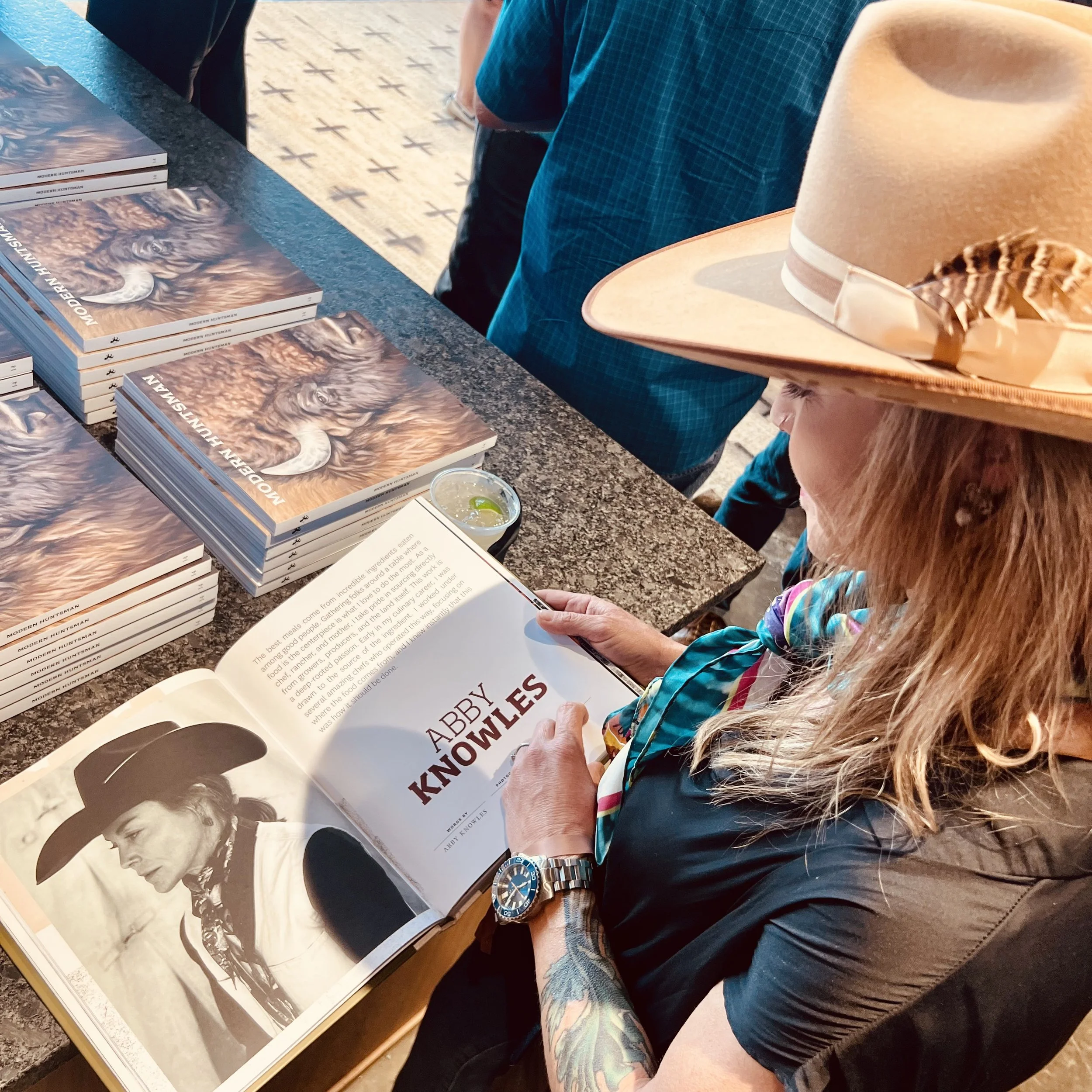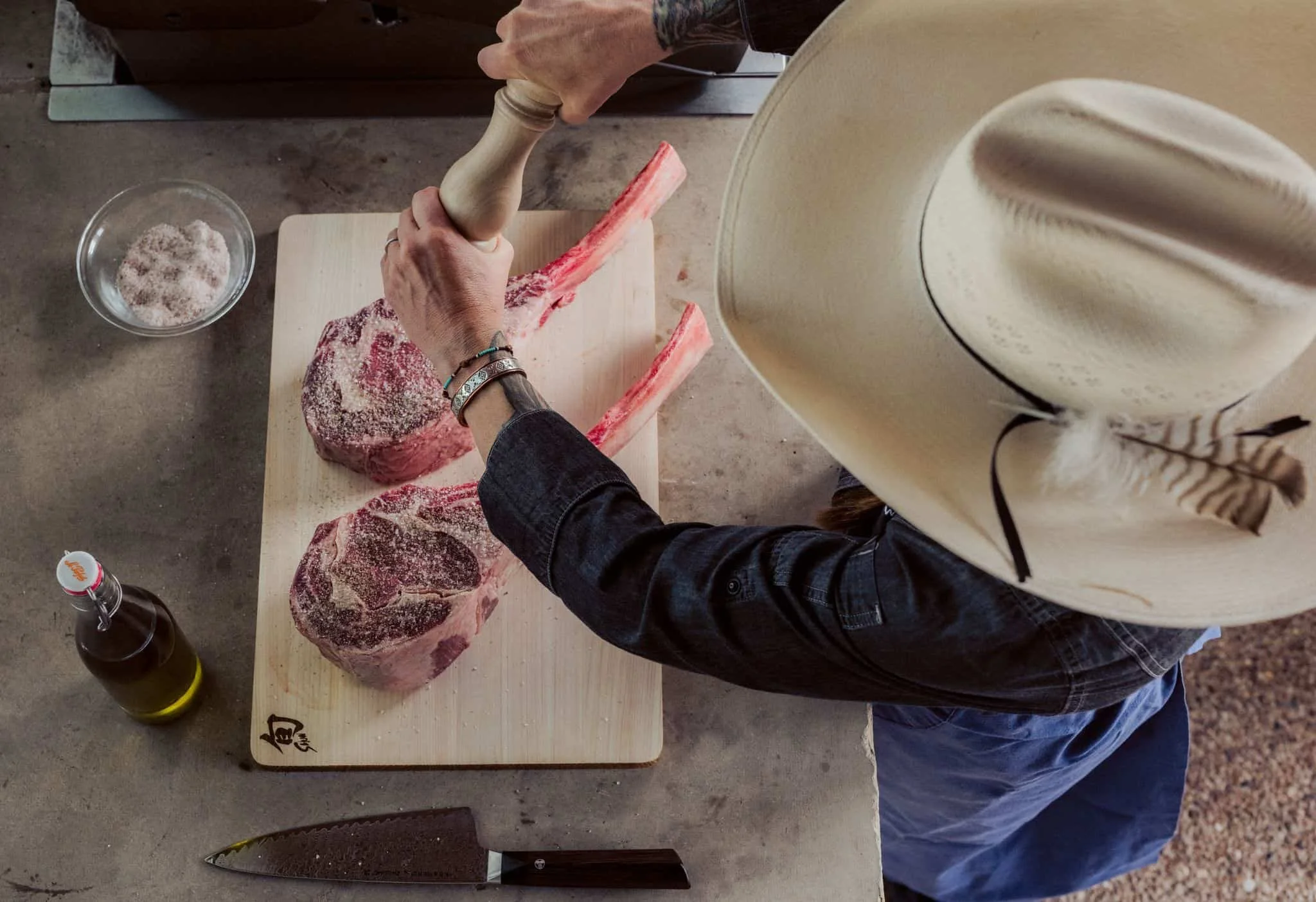Carving A New Legacy
As artists, it is easy to lose ourselves on the trail to greatness, in pursuit of perfection, under the self-inflicted pressure meeting societal standards. It is common to hear about the “madness” of those creative geniuses placed on pedestals by the masses. This holds true for culinary artists as well, though their “torture” is unique in its finite expression. A culinary artist’s blood, sweat and tears funnel into a masterpiece meant to be consumed immediately. Hours or even days of creating have mere moments of gratification. From there, they look for the next rodeo, the next bull to ride, the next adrenaline high. Few can hear the call of this siren. It must be in their blood. The grind, the fire, the emotion, the comradery, and the addiction that usually comes hand in hand… Many burn out. Few reach the top, earning three Michelin stars, and often struggle with purpose once they arrive, seeing nothing left to achieve but to sustain flawlessness. Abby Knowles was all too familiar with this lifestyle as a chef in Ohio’s only Mobil four-star restaurant, but her deep, self-cultivated roots in health and wellness held true north in her escape from the toxicity and eventually to our Cowtown community. Yes, it meant leaving behind the traditional restaurant environment she had worked so hard for, but this was just the beginning.
Abby grew up in a typical Midwestern home in Cincinnati, Ohio with dietary staples of meatloaves and casseroles. A driven athlete uninspired by the regional fare, she began her lifelong culinary education as a teenager when she first began cooking for herself and working in restaurants. Her interest and passion for wellness of people and the planet led her to University of Colorado Boulder, where she earned her bachelor’s degree in environmental studies and competed on the snowboarding and triathlon teams. Winds of curiosity then blew her to Portland, Oregon where she earned her Associate’s Degree in French Culinary Technique with honors at Le Cordon Bleu. There, she dove deeper into ecologically responsible practices as a member of the Farm-to-Table Club, learning a closed-loop relationship between the farm and kitchen, history of cooking methods, and whole animal preparation (using all parts of the animal). Abby returned home to refine her training under renowned French-American chef, Jean-Robert de Cavel, at Pigall’s, establishing a strong foundation in fine dining. She climbed the ladder and later helped him open Lavomatic Café. With a hard right turn, she traded the tumultuous chef lifestyle for her Hallmark love story with childhood friend, Drew Knowles and returned to Boulder, CO with their first daughter.
Increasingly compelled toward making a difference through responsible sourcing and nutrition-focused cuisine, Abby launched a nut butter company in Boulder. She sourced raw materials from the most ecologically conscious farmers that she could find and grew her business from a little farmer’s market stand to regional Wholefoods shelves. Her model shifted, and a new company was born with even deeper driven purpose, Boulder Kitchen Collective. She supplied serious athletes with responsibly sourced, nutrition-calculated meals and snacks. Through this production, Abby continued to expand and strengthen her relationships with farmers and ranchers in the area. Having a relationship with a skilled chef that cultivates a rich following is rare and invaluable, giving farmers a voice. Recognizing this gift, they approached Abby to partner on dinner events at the farms. “They had the space and food. They just needed someone to cook and put it together.” The following grew. Then Covid hit. Thinking on her feet, Abby started a farm box program where she drove to each of the farmers weekly to collect current availability and built a grocery box for clients. This was the clarifying moment for Abby: “This is what I want to do…have my own land and raise my own food.”
When asked “why ranching?”, Chef Abby’s response could not be purer. “Stewardship. We all need land to live. Having livestock on land, done well, is the best way to take care of land…in my opinion.” Little did she know that her dream of caring for her own patch of soil in La Veta, Colorado would lead the Knowles back to their family legacy of the infamous XIT Ranch. Drew is a direct descendant of one of the two Farwell brothers who were paid 3 million acres of the Texas Panhandle in exchange for rebuilding the state capital in Austin. Growth, perseverance, and perhaps a touch of fate resulted in the Knowles acquiring 12,000 acres of the original XIT land, where they now run cattle on the reinstated ranch. Beyond their wildest dreams, the bold couple has expanded the XIT brand with a rapidly growing performance horse division, leading them to plant their home base flag right here on the Brazos.
As a mother first, wife, performance horse breeder, and rancher that maintains peak fitness, Abby has relaxed in this chapter to allow cheffing to come and go with the flow. She continuously seeks opportunity to expand and share her knowledge of holistic food sourcing and preparation, from genetic selection to consumption and everything in between. One interesting facet she has delved into with her beef herd is studying different “finishing” flavor profiles. The good ole fashioned diet of a cow is composed of grasses and other vegetation. But during the last few months, when you are wanting to add fat to the animal for flavor, the diet is usually “finished” by adding grains and or supplements that alter the taste profile dramatically. The same concept applies to all meat sources, including fish. “Grass-finishing,” although many purists think they desire this, produces a lean, astringent flavor profile. Abby has worked through several iterations of “finishing” with restaurants that buy beef from XIT to develop a balanced healthy diet that also results in an attractive flavor profile. The evolution of these trials has included different types of grass, pasture with access to supplements, non-GMO distiller grains, pellets made from distiller grains, and a proprietary blend of beet pulp, corn and alfalfa. Each layer of research and development takes a significant amount of time and energy, but the Sistine Chapel was not accomplished overnight.
Chef Abby’s favorite saying is “Trust your food source.” When I asked her to elaborate, she explained, “You should dig into what you are eating until you know the people, the animals (or plants) and the land it came from. If you feel good about all that, you can feel good about eating it.” The truth is that we cannot currently trust our food system in the United States at face value. It takes diligent research and, better yet, relationships with farmers and ranchers in your own area to find clean, reliable nourishment. Food is the original medicine. Would you take your prescription medication if you knew it had traces of other substances running through it?
In our American fine dining culture, French technique standards have evolved to be equated with value. Tenderloin is king, accompanied by a small portion of vegetables and starches selected more aesthetically than nutritionally. Chefs duel with their ability to perfect the French sauces or plate the food for the most Instagram-able photo. Fine dining has become a programmable machine, holding creative chefs hostage by the societal defined menus. Abby reflects on ordering supplies for the four-star kitchen before a busy weekend. The items will arrive uniform and “perfect” on a truck the next day. But today she reframes it through the eyes of a rancher, “I need 20 tenderloins to get through the weekend. That is two cuts of meat from 10 cows. And now what happens to the rest of the cow?” To break down the math: an average beef cow at slaughter weighs 1400lbs. Hanging weight, or the cooled weight after head, organs, skin, and hooves have been removed is approximately 840lbs. After deboning and trimming excess fat, an average of 570lbs of meat will fill your freezer. Of that meat, you get two tenderloins weighing 4-6lbs each. Here lies the conundrum. People pay a handsome price for a tenderloin filet or ribeye. Yes, they are delicious, but a great, creative chef can work wonders with any cut of the cow when simply given a chance. If consumers will only pay for the same two cuts, how can a chef support local farmers and ranchers who are going the extra mile to maintain healthy, happy animals through a clean, conscientiously sourced diet? At this point, most people would prefer a tenderloin from an animal full of antibiotics and chemical ridden grains than a well prepared and creatively transformed skirt steak raised by his neighbor who can tell you every detail of the cow’s life and intake.
New to our area, Chef Abby has just begun establishing roots and relationships with the wonderful agricultural stewards in our region. Farming and ranching are labors of love that few are inspired to take on. When you feel the fiery passion as the guardian of plants and animals intended to nourish others, it can be maddening when value is misplaced by large corporation marketers and funneled down to consumers. Abby aims to recalibrate these conversations both locally and universally to help people understand “why should you care?” There is a significant language barrier between farms and most tables. Rather than letting fine dining define her, she has managed to harness her experience and skillset as a powerful educational tool…a mouthpiece enabling her to translate the layered legacies of farmers and ranchers into plated poetry understood by all diners fortunate enough to sit in the glow of her cowboy campfire.
Follow @xitranchkitchen on Instagram or xitranch.com for upcoming events on the Brazos to immerse yourself in legacy with Chef Abby Knowles in rebuilding of the brand.







